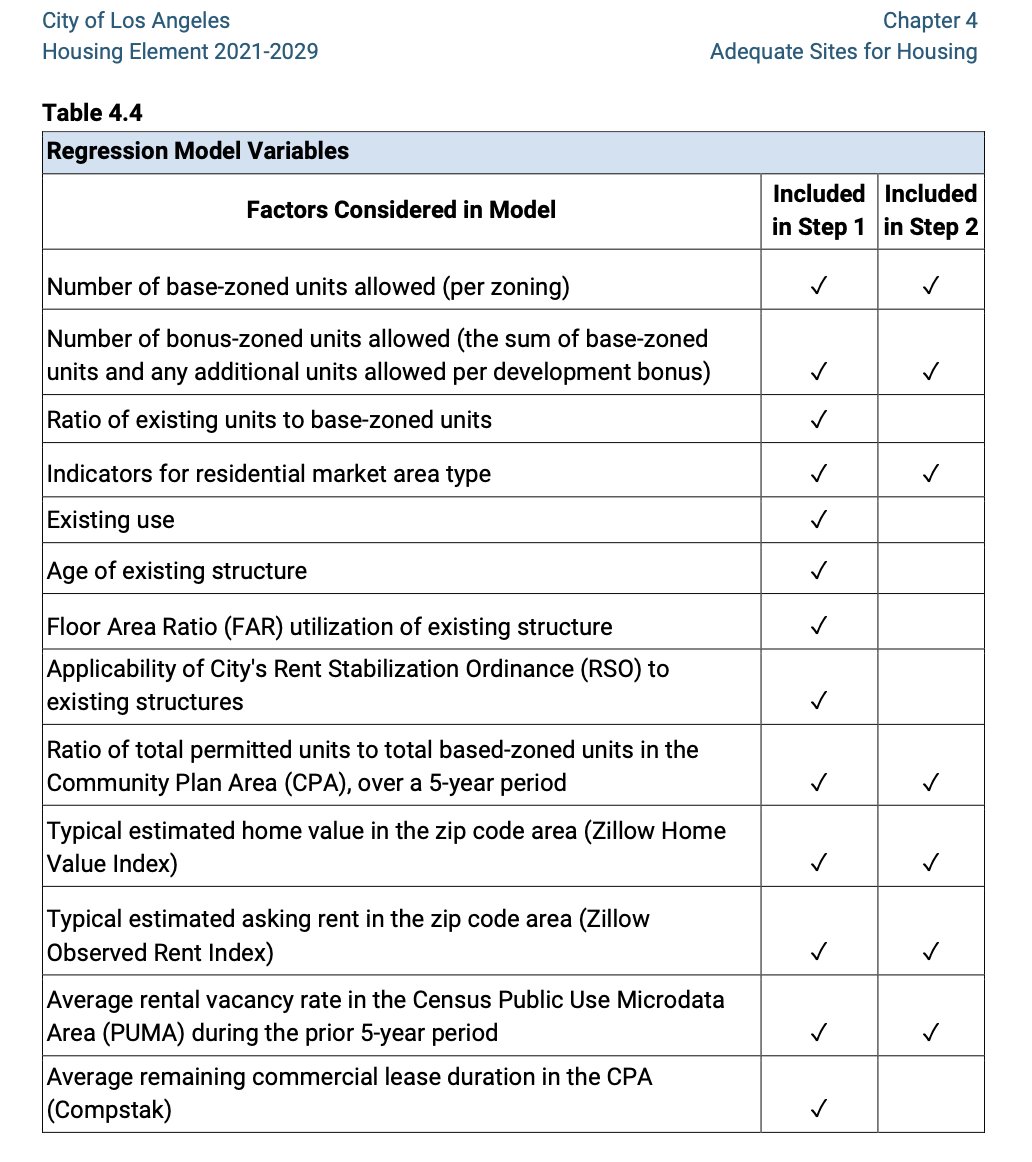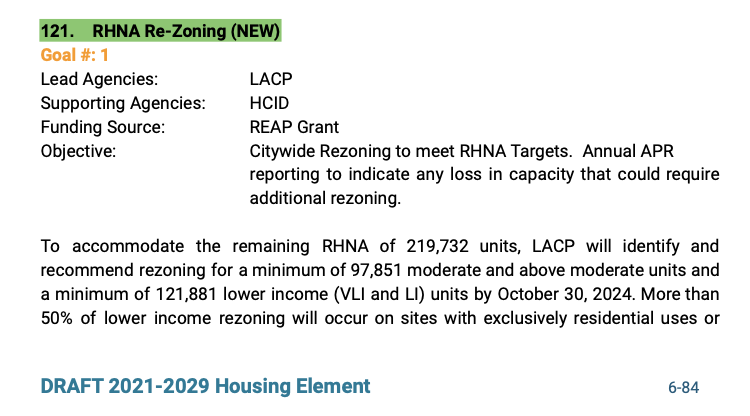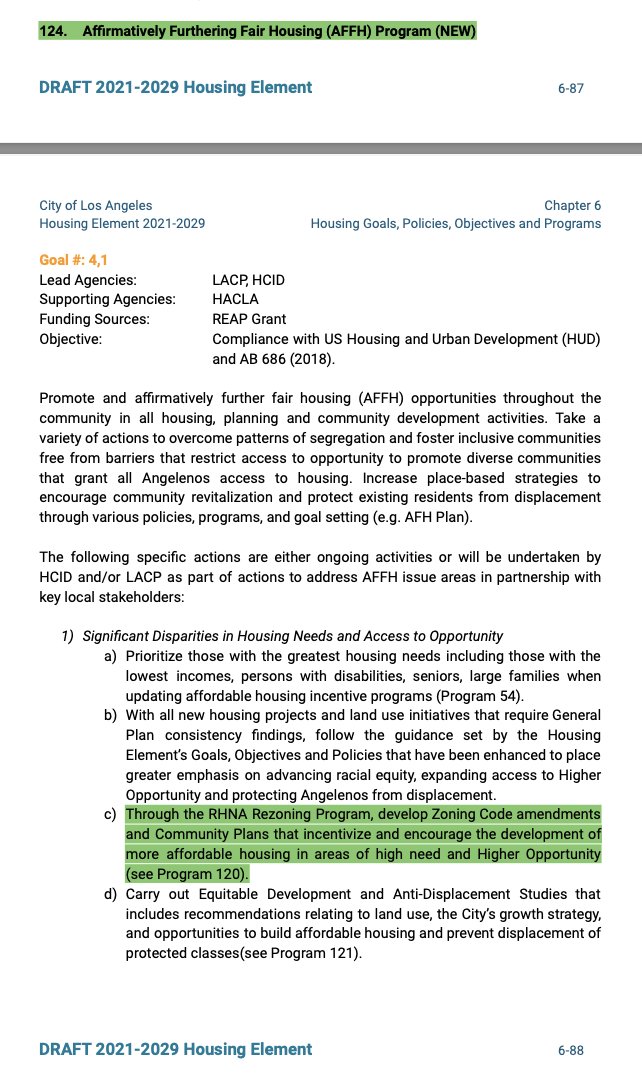
LA's draft housing element just dropped. It's an exemplar, a huge deal not only for LA but for cities across California.
LA is the first city to realistically assess development potential under current zoning, and the results are stunning. 1/18
planning.lacity.org/plans-policies…
LA is the first city to realistically assess development potential under current zoning, and the results are stunning. 1/18
planning.lacity.org/plans-policies…
https://twitter.com/Planning4LA/status/1410736305676251142
As I've explained many times before, cities' assessment of capacity traditionally assumed that every site with near-term development potential *will* be developed during planning period: P(dev) = 1. This assumption is patently false. 2/n
I and co-authors argued in this paper that recent changes to state law empower @California_HCD to require cities to discount site capacity by a rough estimate of the site's likelihood of development during planning period. 3/n
ecologylawquarterly.org/print/making-i…
ecologylawquarterly.org/print/making-i…
https://twitter.com/CSElmendorf/status/1205229693735096320
Subsequently, @California_HCD issued guidance that embraces our idea, but equivocates on whether it's a requirement or a recommendation. 4/n
https://twitter.com/CSElmendorf/status/1276906004114898946
The first big city to submit a housing plan this cycle, San Diego, relied on the old p(dev) = 1 assumption. HCD told San Diego to submit amendments addressing likelihood of development. City's response was a dud. It should be decertified. 5/n
https://twitter.com/CSElmendorf/status/1402438564214833152
LA, by contrast, recruited @issiromem & @TernerHousing to model sites' likelihood of development as function of base and density-bonus zoning, price, and several other predictors. 6/n
planning.lacity.org/odocument/1511…
planning.lacity.org/odocument/1511…

Study shows that if you assume p(dev) = 1, LA has enough excess capacity under current zoning to accommodate ***the entire ~1.4m unit "regional need" of Southern California***, even w/o density bonuses. 7/n 

But analysis also shows that share of sites w/excess capacity that get developed in any given year is tiny, roughly 0.012 for the 5-year period from 2015-2019. 8/n 

The fitted model yields site-specific probabilities of development over the next 5 years ranging from 0 to 0.12. 9/n 

Adjusting the projection period from 5 to 8 years, and incorporating estimates of number of units conditional on development, LA projects that it has realistic capacity for about 47,000 new units on these sites (well shy of 1.4m!). 10/n 

In effect, LA's housing plan assumes that it will realize (as new housing units) only 3.5% of aggregate zoned density of its sites. San Diego, by contrast, assumed that it will realize 90% of zoned density. 11/n
https://twitter.com/CSElmendorf/status/1385302370255466499
And whereas San Diego's ludicrous assumptions allowed it to claim that it has no need to rezone in order to accommodate its share of regional housing need, LA promises a massive rezoning program. 12/n 





LA also forthrightly acknowledges that distribution of its realistic capacity is now skewed toward low-income neighborhoods. In connection w/ AFFH program, city promises to create "zoning budgets" for each of its community plan areas. @ProfSchleich @RickHills2 13/n 





A couple other findings are notable. First, housing developments often realize a greater number of units than zoning nominally allowed (even w/ density bonus).
LA's realistic capacity *nearly doubles* if one accounts for track record of variances & rezonings. 14/n
LA's realistic capacity *nearly doubles* if one accounts for track record of variances & rezonings. 14/n

Second, a lot of development occurred on sites the city classified as having no residential capacity at start of period. Projecting this trend forward, city has realistic capacity on order of 120,000 units, not 47,000. 15/n 

LA doesn't claim credit toward RHNA for this "hidden capacity," but cities ought to receive credit if they show a track record of entitling projects at greater than zoned density, just as they're rewarded for track record of ADU production. 16/n
(minor quibble: it's not clear from the technical appendix, or else I missed it, whether city's realistic capacity estimate accounts for units that would be lost to demolition) 17/n
While most cities don't have staff capacity or consultants to do their own version of LA's analysis, the regional councils of govts should be doing it for them. (I am working now on a related study w/data for all the ABAG cities.) 18/end @AbundantHousing @CamnerLeonora
@anthonydedousis @_jesmcbride @electwizard @Yimby_Law @cayimby @hanlonbt @louismirante @LISC_SD @dillonliam @kimmaicutler @aldot29 @manuelatobiasm @e_baldi @solomonout @JerusalemDemsas @mattyglesias @urbenschneider @BenTMetcalf @SFjkdineen @AlexFischCC @kookie13 @CatBrinkley
@HousingOC @NeverSassyLaura @SonjaTrauss @Scott_Wiener @DavidChiu @SenToniAtkins @ToddGloria @elpaavo @ONeillMoiraK @sidkap_
• • •
Missing some Tweet in this thread? You can try to
force a refresh






